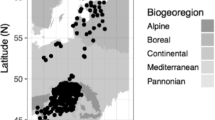Abstract
Evidence for global warming is inferred from spring advances in first-flowering in plants. The trend of average first-flowering times per year for the study group shows a significant advance of 2.4 days over a 30-year period. When 11 species that exhibit later first-flowering times are excluded from the data set, the remaining 89 show a significant advance of 4.5 days. Significant trends for earlier-flowering species range from -3.2 to -46 days, while those for later-flowering species range from +3.1 to +10.4 days. Advances of first-flowering in these 89 species are directly correlated with local increase in minimum temperature (T min).
Similar content being viewed by others
References
Alward RD,Detling JK andMilchunas DG (1999) Grassland vegetation changes and nocturnal global warming. Science 283: 229-231
Chapin FS,Shaver G,Giblin A,Nadelhoffer K andLaundre J (1995) Responses of arctic tundra to experimental and observed changes in climate. Ecology 76: 694-711
Easterling DR,Horton B,Jones PD,Peterson TC,Karl TR,Parker DE,Salinger MJ,Razuvayev V,Plummer N,Jamason P andFolland CK (1997) Maximum and minimum temperature trends for the globe. Science 277: 364-367
Houghton JT,Meria Filho LG,Callender B andHarris N (eds.) (1995) The Science of Climate Change. Cambridge University Press, Cambridge
Kartesz JT (1994) A Synonymized Checklist of the United States, Canada, and Adjacent Greenland, 2nd edn. (2 vols.) Timber Press, Portland, Oregon
Melillo JM (1999) Climate change: warm, warm on the range. Science 283: 183-184
Menzel A andFabian P (1999) Growing season extended in Europe. Nature 397: 659
Salisbury FB andRoss CW (1992) Plant Physiology, 4th edn., Wadsworth Publishing Company, Belmont
Shetler SG andOrli SS (2000) Annotated Checklist of the Vascular Plants of the Washington-Baltimore Area. Part I. Ferns, Fern Allies, Gymnosperms, and Dicotyledons. Smithsonian Institution (National Museum of Natural History, Department of Botany), Washington, DC
Shetler SG andWiser SK (1987) First flowering dates for spring-blooming plants of the Washington, DC, area for the years 1970 to 1983. Proceedings of the Biological Society of Washington 100: 993-1017
Author information
Authors and Affiliations
Rights and permissions
About this article
Cite this article
Abu-Asab, M.S., Peterson, P.M., Shetler, S.G. et al. Earlier plant flowering in spring as a response to global warming in the Washington, DC, area. Biodiversity and Conservation 10, 597–612 (2001). https://doi.org/10.1023/A:1016667125469
Issue Date:
DOI: https://doi.org/10.1023/A:1016667125469




